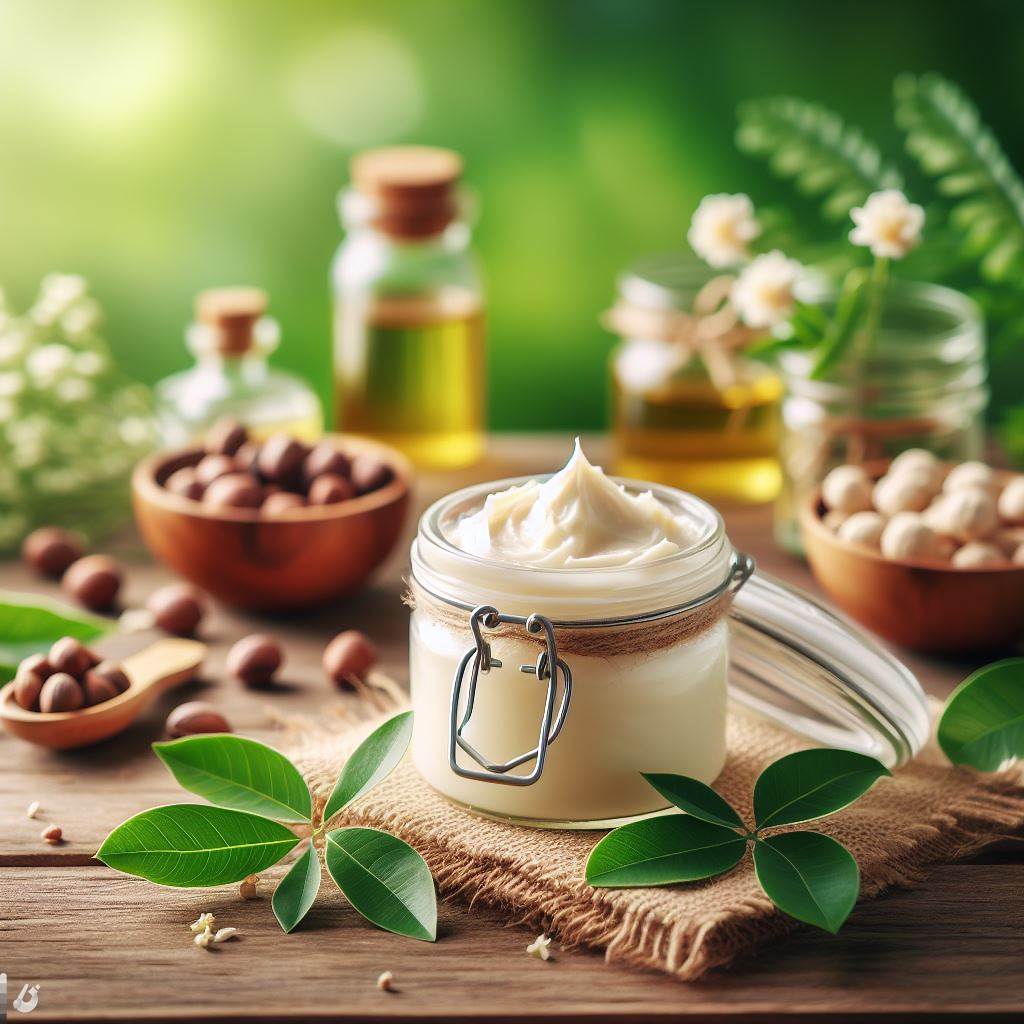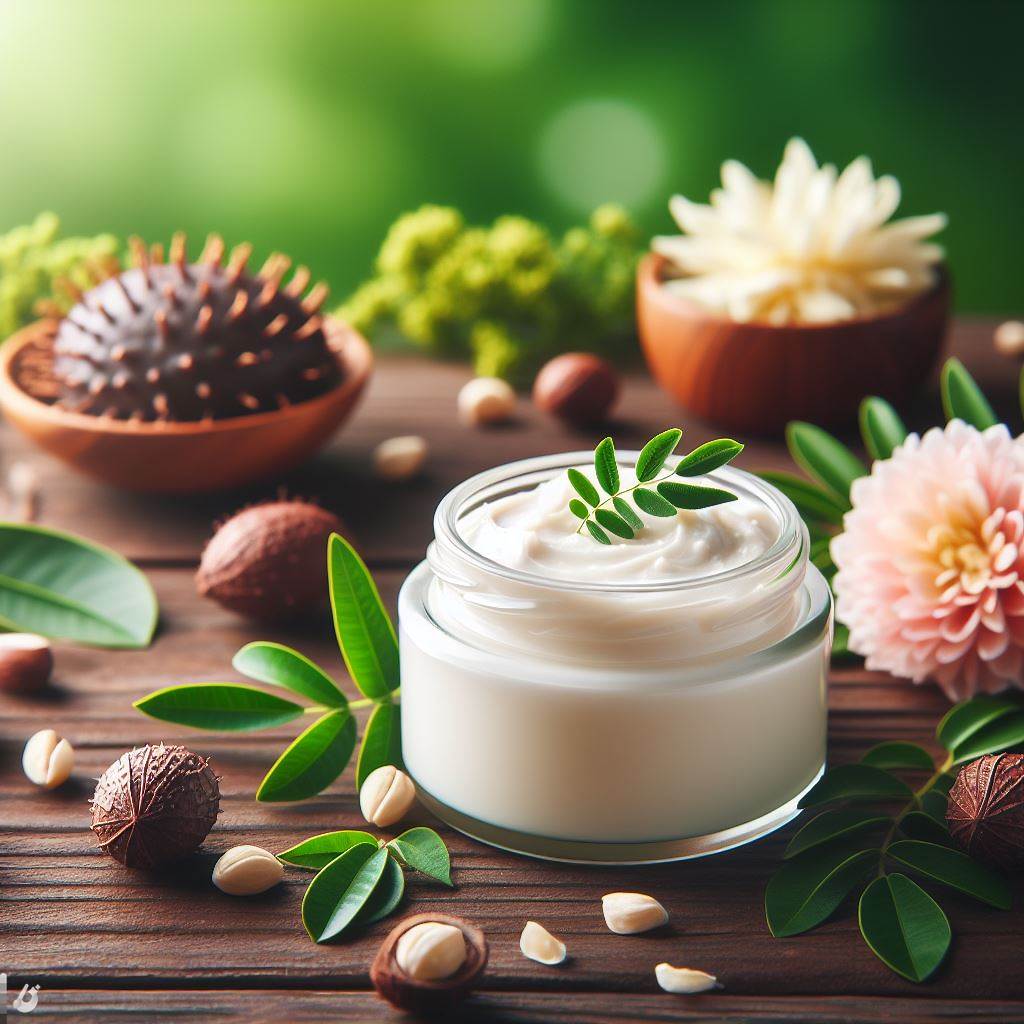Introducing shea butter, the versatile cosmetic ingredient that has taken the beauty industry by storm. With its rich history and countless benefits, shea butter has become a staple in skincare and haircare routines worldwide. Known for its nourishing and moisturizing properties, shea butter is derived from the nuts of the shea tree, native to Africa. Packed with vitamins A, E, and F, as well as essential fatty acids, it deeply hydrates and soothes the skin, leaving it soft, supple, and radiant. But that’s not all! Shea butter is also a powerhouse for hair health. Its natural emollient properties make it an excellent conditioner, promoting stronger, healthier hair and combating dryness and frizz. Whether you’re looking to repair damaged hair or add shine and luster, shea butter has got you covered. Furthermore, shea butter is renowned for its anti-inflammatory and anti-aging benefits. It helps to reduce redness, irritation, and the appearance of wrinkles, making it a top pick for those seeking youthful-looking skin. Make shea butter a part of your daily beauty routine and experience the transformative power of this incredible ingredient. Embrace the natural, nourishing qualities of shea butter and unlock the beauty that lies within.
The History and Origin of Shea Butter
Shea butter has been used for centuries in Africa for its skincare benefits. It originates from the nuts of the shea tree, scientifically known as Vitellaria paradoxa. The tree is native to the African savannah and is grown mainly in West Africa. The process of extracting shea butter involves harvesting the nuts, drying them, crushing them, and then boiling them to extract the butter. This traditional method has been passed down through generations, ensuring the preservation of shea butter’s natural properties. Today, shea butter is not only valued for its cosmetic benefits but also for its social and economic impact on communities in Africa.
Shea butter has a long history of use in African skincare rituals. Ancient Egyptian queens such as Cleopatra were known to use shea butter to keep their skin soft and supple. The butter was also used to protect the skin from the harsh African sun and to heal wounds and scars. Over the years, shea butter has gained popularity worldwide, and its benefits have been recognized by the beauty industry.
The Manufacturing Process of Shea Butter
The manufacturing process of shea butter begins with the collection of shea nuts. The nuts are harvested from the shea tree and then left to dry in the sun. Once dried, the outer shell is removed, revealing the shea kernel. The kernels are then roasted, crushed, and ground into a paste. This paste is then kneaded and mixed with water until the oil separates from the solids. The oil is then further refined and filtered to remove any impurities, resulting in pure shea butter.
The traditional method of shea butter extraction is still widely practiced in Africa, as it helps to preserve the natural properties of the butter. However, modern manufacturing techniques have also been developed to meet the growing demand for shea butter worldwide. These techniques involve the use of mechanical presses and other machinery to extract the butter more efficiently. Regardless of the manufacturing method, the quality and efficacy of shea butter remain intact, making it a valuable ingredient in the beauty industry.
Benefits of Shea Butter for Skincare
Shea butter is a true powerhouse when it comes to skincare. Its high concentration of vitamins A, E, and F, as well as essential fatty acids, make it a deeply nourishing and moisturizing ingredient. When applied to the skin, shea butter forms a protective barrier that helps to retain moisture, preventing dryness and dehydration. Its emollient properties also make it an effective treatment for various skin conditions, such as eczema, psoriasis, and dermatitis.
In addition to its moisturizing benefits, shea butter also has anti-inflammatory properties that can help soothe and calm irritated skin. It can reduce redness, swelling, and itching, making it an excellent choice for those with sensitive or reactive skin. Shea butter is also known to promote collagen production, which can help improve the skin’s elasticity and firmness. Regular use of shea butter can lead to smoother, softer, and more youthful-looking skin.
To incorporate shea butter into your skincare routine, look for products that contain high-quality, unrefined shea butter. These products will retain the natural properties of shea butter and provide the most benefits for your skin. Whether you choose a shea butter cream, lotion, or oil, make sure to apply it generously to clean, dry skin and massage it in using gentle, circular motions. Allow the butter to absorb fully before applying any other products or makeup.

Shea Butter as a Haircare Ingredient
Shea butter’s benefits extend beyond skincare, making it a popular ingredient in haircare products as well. Its natural emollient properties make it an excellent conditioner, providing deep hydration and nourishment to the hair and scalp. Shea butter can help combat dryness, frizz, and breakage, leaving the hair smooth, shiny, and manageable.
One of the key advantages of using shea butter on the hair is its ability to penetrate the hair shaft and lock in moisture. This helps to repair and strengthen damaged hair, reducing the appearance of split ends and promoting overall hair health. Shea butter is also known to stimulate hair growth by nourishing the hair follicles and improving blood circulation in the scalp.
To reap the benefits of shea butter for your hair, look for haircare products specifically formulated with shea butter as a key ingredient. These products can range from shampoos and conditioners to leave-in treatments and styling products. Apply the product to clean, damp hair, focusing on the ends and avoiding the roots. Gently comb through the hair to distribute the butter evenly, and then style as desired. With regular use, you’ll notice stronger, healthier hair that is more resistant to damage.
Shea Butter for Treating Skin Conditions

Shea butter is not only a moisturizing powerhouse but also a valuable ingredient for treating various skin conditions. Its anti-inflammatory and healing properties make it an effective remedy for conditions such as eczema, psoriasis, and dermatitis. Shea butter helps to reduce inflammation, soothe itching, and promote the healing of damaged skin.
When using shea butter to treat skin conditions, it’s important to choose a high-quality, unrefined product. Look for shea butter that is free from added fragrances, preservatives, and other potential irritants. Apply the butter to the affected areas of the skin, massaging it in gently until absorbed. For best results, use shea butter consistently and as part of a comprehensive skincare routine. Consult a dermatologist if you have severe or persistent skin conditions to ensure proper diagnosis and treatment.
Different Types of Shea Butter and Their Uses
Shea butter comes in various forms, each with its own unique properties and uses. The most common types of shea butter include unrefined shea butter, refined shea butter, and whipped shea butter. Unrefined shea butter is the purest form and retains all of its natural nutrients and benefits. It has a rich, nutty aroma and a yellowish color. Refined shea butter, on the other hand, undergoes additional processing to remove any impurities and odor. It has a lighter color and a milder scent. Whipped shea butter is a popular variation that has been whipped to create a fluffy, creamy texture that is easier to apply.
Unrefined shea butter is ideal for those seeking maximum moisturizing and nourishing benefits. It can be used on the face, body, and hair, providing a deep hydration boost. Refined shea butter is a more versatile option, suitable for those with sensitive skin or those who prefer a milder scent. It can be used in a variety of skincare and haircare products, including lotions, creams, and balms. Whipped shea butter is perfect for those who prefer a lighter texture and easy application. It can be used as a body butter, lip balm, or even as a hair mask.
How to Incorporate Shea Butter into Your Skincare Routine
Incorporating shea butter into your skincare routine is easy and can provide numerous benefits for your skin. Here are some simple steps to help you get started:
1. Cleanse your face with a gentle cleanser suitable for your skin type.
2. Pat your skin dry with a clean towel, leaving it slightly damp.
3. Take a small amount of shea butter and warm it up between your palms.
4. Gently massage the shea butter onto your face, focusing on areas that need extra hydration or treatment.
5. Allow the shea butter to absorb fully into your skin before applying any other products.
6. Follow up with a moisturizer or sunscreen, if desired.
7. Repeat this routine morning and night for best results.
Remember, consistency is key when it comes to skincare. Incorporating shea butter into your routine on a regular basis will help you achieve and maintain healthy, radiant skin.
Common Misconceptions About Shea Butter
Despite its numerous benefits, shea butter is sometimes subject to misconceptions. Let’s debunk some of the common myths surrounding this incredible ingredient:
Myth 1: Shea butter clogs pores. Shea butter is non-comedogenic, meaning it does not clog pores. In fact, it helps to balance the skin’s natural oil production and can even help to regulate sebum production in oily skin types.
Myth 2: Shea butter is only for dry skin. While shea butter is excellent for dry skin, it can benefit all skin types. Its lightweight texture allows it to absorb quickly into the skin, leaving it moisturized without feeling greasy.
Myth 3: Shea butter is greasy and heavy. When used in the right amounts, shea butter should not feel greasy or heavy on the skin. It has a natural lightweight texture that melts into the skin, providing hydration without leaving a residue.
Myth 4: Shea butter is only for women. Shea butter is a gender-neutral ingredient suitable for everyone. Its versatile nature makes it beneficial for both men and women, regardless of their skincare concerns.
Myth 5: All shea butter is the same. Not all shea butter is created equal. The quality and efficacy of shea butter can vary depending on factors such as the sourcing, manufacturing process, and storage conditions. Opt for high-quality, unrefined shea butter to experience its full benefits.
Final Thoughts on Shea Butter
Shea butter is truly a cosmetic ingredient worth embracing in your beauty routine. Its rich history, numerous benefits, and versatility make it a must-have for skincare and haircare enthusiasts. Whether you’re seeking hydration, anti-aging benefits, or a solution for specific skin conditions, shea butter has got you covered. From its origins in Africa to its global popularity, shea butter continues to transform the beauty industry. Embrace the natural, nourishing qualities of shea butter and unlock the beauty that lies within.